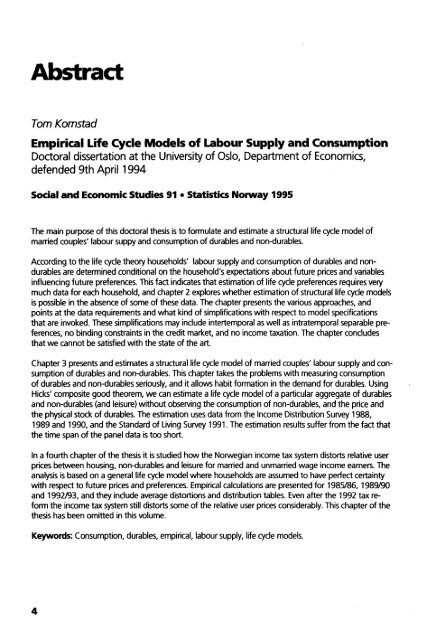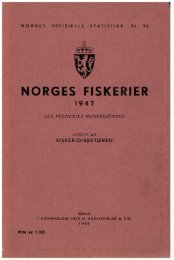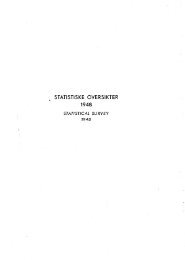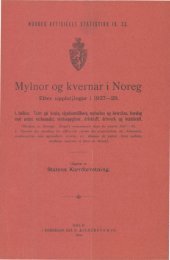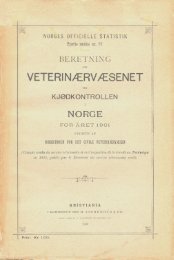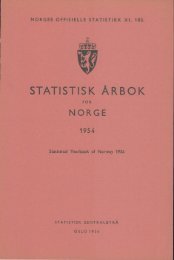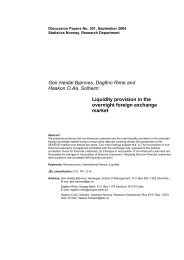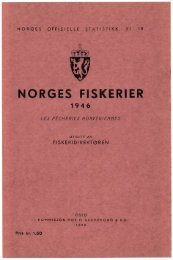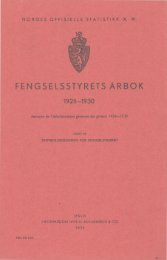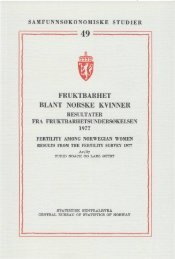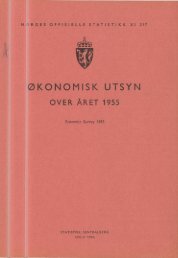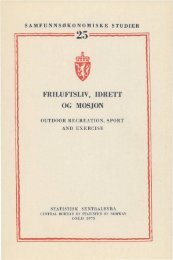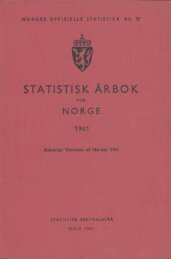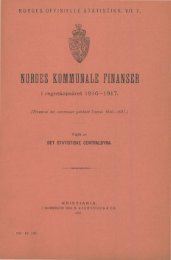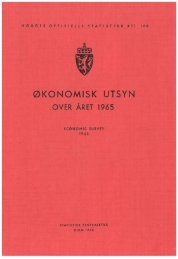Empirical life cycle models of labour supply and - Statistisk sentralbyrå
Empirical life cycle models of labour supply and - Statistisk sentralbyrå
Empirical life cycle models of labour supply and - Statistisk sentralbyrå
You also want an ePaper? Increase the reach of your titles
YUMPU automatically turns print PDFs into web optimized ePapers that Google loves.
Abstract<br />
Tom Kornstad<br />
<strong>Empirical</strong> Life Cycle Models <strong>of</strong> Labour Supply <strong>and</strong> Consumption<br />
Doctoral dissertation at the University <strong>of</strong> Oslo, Department <strong>of</strong> Economics,<br />
defended 9th April 1994<br />
Social <strong>and</strong> Economic Studies 91 • Statistics Norway 1995<br />
The main purpose <strong>of</strong> this doctoral thesis is to formulate <strong>and</strong> estimate a structural <strong>life</strong> <strong>cycle</strong> model <strong>of</strong><br />
married couples' <strong>labour</strong> suppy <strong>and</strong> consumption <strong>of</strong> durables <strong>and</strong> non-durables.<br />
According to the <strong>life</strong> <strong>cycle</strong> theory households' <strong>labour</strong> <strong>supply</strong> <strong>and</strong> consumption <strong>of</strong> durables <strong>and</strong> nondurables<br />
are determined conditional on the household's expectations about future prices <strong>and</strong> variables<br />
influencing future preferences. This fact indicates that estimation <strong>of</strong> <strong>life</strong> <strong>cycle</strong> preferences requires very<br />
much data for each household, <strong>and</strong> chapter 2 explores whether estimation <strong>of</strong> structural <strong>life</strong> <strong>cycle</strong> <strong>models</strong><br />
is possible in the absence <strong>of</strong> some <strong>of</strong> these data. The chapter presents the various approaches, <strong>and</strong><br />
points at the data requirements <strong>and</strong> what kind <strong>of</strong> simplifications with respect to model specifications<br />
that are invoked. These simplifications may include intertemporal as well as intratemporal separable preferences,<br />
no binding constraints in the credit market, <strong>and</strong> no income taxation. The chapter concludes<br />
that we cannot be satisfied with the state <strong>of</strong> the art.<br />
Chapter 3 presents <strong>and</strong> estimates a structural <strong>life</strong> <strong>cycle</strong> model <strong>of</strong> married couples' <strong>labour</strong> <strong>supply</strong> <strong>and</strong> consumption<br />
<strong>of</strong> durables <strong>and</strong> non-durables. This chapter takes the problems with measuring consumption<br />
<strong>of</strong> durables <strong>and</strong> non-durables seriously, <strong>and</strong> it allows habit formation in the dem<strong>and</strong> for durables. Using<br />
Hicks' composite good theorem, we can estimate a <strong>life</strong> <strong>cycle</strong> model <strong>of</strong> a particular aggregate <strong>of</strong> durables<br />
<strong>and</strong> non-durables (<strong>and</strong> leisure) without observing the consumption <strong>of</strong> non-durables, <strong>and</strong> the price <strong>and</strong><br />
the physical stock <strong>of</strong> durables. The estimation uses data from the Income Distribution Survey 1988,<br />
1989 <strong>and</strong> 1990, <strong>and</strong> the St<strong>and</strong>ard <strong>of</strong> Living Survey 1991. The estimation results suffer from the fact that<br />
the time span <strong>of</strong> the panel data is too short.<br />
In a fourth chapter <strong>of</strong> the thesis it is studied how the Norwegian income tax system distorts relative user<br />
prices between housing, non-durables <strong>and</strong> leisure for married <strong>and</strong> unmarried wage income earners. The<br />
analysis is based on a general <strong>life</strong> <strong>cycle</strong> model where households are assumed to have perfect certainty<br />
with respect to future prices <strong>and</strong> preferences. <strong>Empirical</strong> calculations are presented for 1985/86, 1989/90<br />
<strong>and</strong> 1992193, <strong>and</strong> they include average distortions <strong>and</strong> distribution tables. Even after the 1992 tax reform<br />
the income tax system still distorts some <strong>of</strong> the relative user prices considerably. This chapter <strong>of</strong> the<br />
thesis has been omitted in this volume.<br />
Keywords: Consumption, durables, empirical, <strong>labour</strong> <strong>supply</strong>, <strong>life</strong> <strong>cycle</strong> <strong>models</strong>.<br />
4


